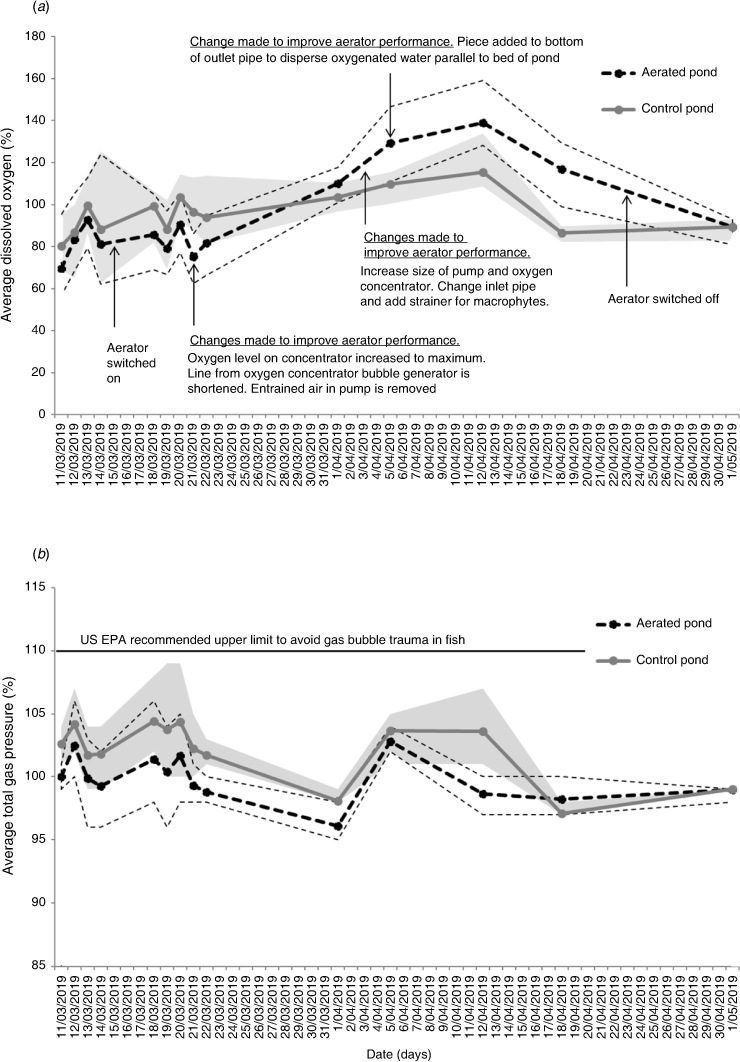Field trials to determine the efficacy of aerators to mitigate hypoxia in inland waterways
Darren S. Baldwin A B G , Craig A. Boys
A B G , Craig A. Boys  C D , Ann-Marie Rohlfs E , Iain Ellis
C D , Ann-Marie Rohlfs E , Iain Ellis  F and Joe Pera
F and Joe Pera  E
E
A School of Agricultural, Environmental and Veterinary Sciences, Charles Sturt University, Elizabeth Mitchell Drive, Thurgoona, NSW 2640, Australia.
B Rivers and Wetlands, Lipsett Road, Thurgoona, NSW 2640, Australia.
C New South Wales Department of Primary Industries, Port Stephens Fisheries Institute, Taylors Beach Road, Taylors Beach, NSW 2316, Australia.
D Institute for Land Water and Society, Charles Sturt University, Thurgoona, NSW 2640, Australia.
E WaterNSW, 169 Macquarie Street, Parramatta, NSW 2150, Australia.
F Department of Primary Industries, Buronga, NSW 2739, Australia.
G Corresponding author. Email: dbaldwin@csu.edu.au
Marine and Freshwater Research 73(2) 211-222 https://doi.org/10.1071/MF20365
Submitted: 15 December 2020 Accepted: 30 June 2021 Published: 13 September 2021
Journal Compilation © CSIRO 2022 Open Access CC BY-NC-ND
Abstract
Following a series of fish deaths in the lower Darling River in the austral summer of 2018–19, several field trials were undertaken over two summers to determine the efficacy of various aerators to mitigate the effects of hypoxia to prevent fish deaths. The aerators evaluated included: low-powered, solar bubble-plume diffusers; high-flow, single-port Venturi systems; pontoon-mounted multi-port Venturi systems; and an ultra-fine bubble generator. The effectiveness of bubble diffusers appears related to their power, the number of units used and their running time. Pontoon-mounted multi-port Venturi aerators and high-flow, single-port Venturi aerators were much more successful in maintaining oxygen levels and may have prevented fish deaths in the Darling River in early 2019. However, the Venturi aerators were expensive to run, consuming hundreds to thousands of litres of diesel fuel per week. Trial of an ultra-fine oxygen bubble pump showed promise because it supersaturated the water with dissolved oxygen while not elevating total gas pressure to levels that would cause gas-bubble trauma in fish. Although aerators may play a role in emergency responses to hypoxic fish deaths, they have limitations regarding their area of influence (at best thousands of square metres) and their cost to deploy and operate.
Keywords: fish deaths, re-aeration, river management, stratification.
Introduction
Most of inland Australia is either arid or semi-arid. As a result, many Australian inland lowland rivers are intermittent: during periods of drought they cease to flow, reducing to a series of pools or becoming totally dry on occasion. Like other intermittent rivers and ephemeral streams elsewhere in the world (Gomez et al. 2017), ephemeral rivers in Australia are susceptible to periods of poor water quality (Baldwin 2020a), especially periods of low oxygen concentrations in the water column. Hypoxia (low concentrations of dissolved oxygen, DO) and anoxia (no DO) have contributed to a significant number of fish deaths in inland Australia. Recent examples include substantial fish deaths following the recommencement of flows in the Darling River in 2004 (Ellis and Meredith 2004), flooding in the Murray River in 2010 (King et al. 2012; Whitworth et al. 2012) and a series of three fish kill events in the Darling River during the summer of 2018–19 that resulted in millions of dead fish (Vertessy et al. 2019). There was also a fish kill in the Murrumbidgee River that coincided with the last of the three fish death events in the Darling River (Baldwin 2019a).
There are numerous ways that DO concentrations in inland waterways can fall to levels that are lethal to fish, generally thought to be between 2 mg O2 L–1 (Gehrke 1988) and 3 mg O2 L–1 (Small et al. 2014) for large-bodied Australian native fish. The 2010 deaths in the Murray River and its tributaries were caused by hypoxic blackwater (Whitworth et al. 2012), generated by the inundation of flood plain that had remained dry for several years. Dissolved organic carbon was leached from both live and dead vegetation on the flood plain. The dissolved organic carbon was consumed by bacteria, in turn consuming oxygen. The rate of oxygen replenishment from the atmosphere was less than the rate of oxygen consumption, resulting in a deficit in oxygen concentrations in the water column.
The 2018–19 fish deaths in the lower Darling River in New South Wales (NSW), Australia, were caused by hypoxia in the water column following destratification (Baldwin 2019b). Under low- and no-flow conditions the water column in a river channel can become thermally stratified. Thermal stratification is caused by the differential heating of surface water compared with bottom water (hypolimnion). The surface water absorbs heat and so becomes less dense and floats on the cooler bottom waters. Oxygen consumption by microbes in the sediment removes oxygen in the bottom waters. Because the bottom waters are not mixing with surface waters, reoxygenation from the air does not occur, which can lead to hypoxia in the hypolimnion. During a mixing event, the hypolimnic water mixes with the surface layer, which can lead to hypoxia throughout the water column.
Other factors that can lead to hypoxia in inland waterways include algal blooms and the disturbance of acid sulfate soils. During a large algal bloom, the DO concentration can change from supersaturation to near hypoxia in a 24-h period as the algae shift from photosynthesis during the day to respiration at night (see McDonnell and Kountz 1966). Inland acid sulfate soils have only relatively recently been recognised as an issue in inland waterways (Environment Protection and Heritage Council and the Natural Resources Management Ministerial Council 2011). They are formed when bacteria use sulfate as an electron acceptor during anaerobic respiration. Sulfate is reduced to sulfide, which, in turn, reacts with metal ions to form mineral sulfides. If the sulfidic sediments are exposed to oxygen they are oxidised, consuming oxygen in the process. In extreme cases this can lead to hypoxia (e.g. Sullivan et al. 2002).
There are several intervention strategies that may be used to minimise the impact of hypoxia on fish communities, including flow manipulations (e.g. Watts et al. 2018), chemical ameliorants (e.g. Dunalska et al. 2015) and physical oxygenation (Whitworth et al. 2013). Although the use of these strategies is common in aquaculture, their deployment in response to potential or actual fish deaths in river systems is much rarer. When interventions are undertaken, they tend to be reactive and often are not accompanied by a robust monitoring program to determine their efficacy. A series of massive fish deaths in the lower Darling River in December 2018 and January 2019 caused by destratification of a disconnected weir pool (Baldwin 2019b) initiated an emergency response with the objective of protecting fish in other disconnected pools until flows in the system returned. A desktop review (Boys et al. 2021) led to several different mechanical aeration and mixing devices being deployed immediately into the lower Darling River because they were considered to be of low environmental risk and were could be deployed quickly in remote areas by government staff and members of the general public without extensive technical expertise or training. The deployments were to be treated as pilot trials and their effectiveness monitored. The aerators were deployed from January to April 2019 and again over the subsequent summer of 2019–20. An additional aerator trial was performed by WaterNSW in the summer of 2019–20 to protect refuge pools in a section of the lower Macquarie River that was considered at high risk of fish deaths. Furthermore, a pilot trial of an ultra-fine oxygen-bubble pump was undertaken in a small pond at a government native fish hatchery. This paper presents a synthesis of these quasi-independent trials in order to assess the effectiveness and limitations of various aerator technologies in mitigating hypoxia in semi-arid lowland rivers with the specific aim of progressing our understanding on how to respond to future events. These studies were chosen because in each instance a robust monitoring program was implemented as a part of the aerator deployment and reference stations (without aerators) were included in the study design.
Materials and methods
Overview
This synthesis considers the results of four quasi-independent trials of aerators at three locations in the Murray–Darling Basin (Fig. 1) during the period from January 2019 until April 2020. Various aerators were deployed in the individual trials (Table 1), including:
-
high-volume, single-port Venturi aerators, which used a high-volume water pump (either 30.5 or 66 cm) to push water through a single-port Venturi aerator
-
multi-port Venturi aerators, which were composed of a pump on a floating pontoon. The pump draws water from a depth of ~1 m and discharges the water onto the water surface through either four or six Venturi outlets at a rate of between 2 and 8 ML day–1
-
solar-powered bubble diffusers with or without battery storage, which pump air through diffusers placed at the bottom of the waterbody, creating a bubble plume that rises to the surface, entraining water in the process
-
ultra-fine bubble-injection pumps, which create bubbles with a diameter <1 µm that persist in the water column.

|
Darling River, February–May 2019
Following successive fish deaths in the Darling River in 2018 and early 2019, aerators were deployed in the lower Darling River in early 2019 for a period of up to 3 months (see Table S1 of the Supplementary material). The aerators deployed included commercially available multi-port Venturi aerators (with a power output of between 5.5 and 7.5 kW) powered by diesel–electric generators, a diesel-powered 30.5-cm water pump pushing water through a single-port Venturi aerator at a rate of 10–15 ML day–1 and several low-powered (~0.5 kW) solar bubble-plume diffusers.
A multi-port Venturi aerator was installed in each of two isolated pools, one immediately downstream of Weir 32 on the Darling River near Menindee NSW (2019-A) and one ~600 m downstream of Weir 32 (2019-B). These pools were selected for aerators because fish moving upstream had aggregated in them in late 2018 before the complete cease of flow in January 2019. A reference station without an aerator (2019-C) was established in a third residual pool ~1.4 km downstream of Weir 32.
A 30.5-cm water pump connected to a purpose-built Venturi aerator was installed upstream of a block bank on the Darling River at Karoola Station in January 2019 (Table S1). Water was pumped across a narrow strip of land, then through a single-port Venturi aerator to an outlet point (2019-D; Fig. S1 of the Supplementary material). A solar-powered bubble-plume diffuser (2019-E) was also deployed in the same pool, ~3400 m downstream of 2019-D. The efficacy of the aerators in the Karoola block bank pool were determined by comparing water quality near the aerators with a reference station in the same block bank pool located approximately equidistant between the two units (2019-F; Fig. 2). A solar-powered aerator (2019-G) and upstream reference station (2020-H) were established in Pooncarie Weir Pool. A solar-powered bubble-plume diffuser was also deployed in an isolated pool upstream of Burtundy (2019-I) and its efficacy was compared with a reference station in a pool a further 4 km downstream (2019-J).
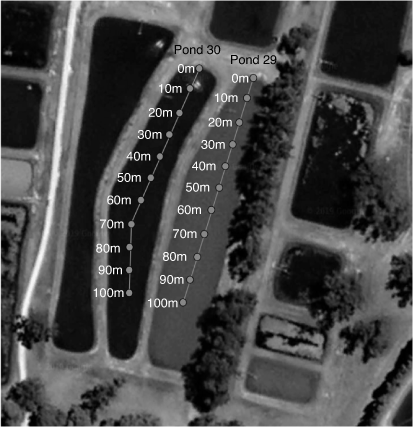
|
Sampling at each site was undertaken either weekly or every 2 weeks from February until April or May depending on the site (Table S1), with the exception that 4 weeks elapsed between the second-last and last sampling trips as a result of rainfall and road closures. At each sampling site, temperature, DO concentration, electrical conductivity and pH were measured at 0.5-m intervals throughout the water column. At each of the aerator sites additional measurements were taken along longitudinal transects to capture the extent of the influence of the aerators. At four sites (2019-D, 2019-F, 2019-G and 2019-H) D-Opto loggers (Zebra Tech) were deployed beneath the surface and just off the bottom of the pool. The D-Opto loggers were programmed to measure DO concentration and water temperature every 15 min. The loggers were retrieved on every sampling trip, cleaned and then redeployed. This meant that, with the exception of the last sampling trip, the loggers were deployed for no longer than ~1 week between cleaning.
Darling River, December 2019–April 2020
Pontoon-mounted multi-port Venturi aerators were deployed in Lake Wetherell (2020-A) and in Weir 32 (2020-C) from late November 2019 to March 2020 (Table S1). Temperature and DO concentration profiles were determined at stations 5, 25, 50 and 100 m immediately downstream of each aerator and at reference stations between 1000 m (2020-B) and 1500 m (2020-D) upstream of aerators 2020-A and 2020-C respectively.
A 66-cm water pump and Venturi aerator were deployed in the Weir 32 weir pool (2020-E; Table S1). Water was piped from a point ~2300 river metres downstream of the outlet at a rate of 70–100 ML day–1 to the Venturi aerator outlet across a narrow strip of land on an elongated bend in the river (analogous to Fig. S1). DO and temperature profiles were collected at a series of eight stations starting 250 m upstream of the Venturi aerator outlet and ending at a station 200 m downstream of the Venturi aerator inlet (a total distance of ~2.5 river kilometres). A reference station 2020-F was located 1500 m upstream of the aerator.
Sampling occurred at all sites at least weekly, typically between 0800 and 1000 hours Australian Eastern Summer Time. DO and temperature profiles were measured using a YSI ProSolo meter. In addition, a thermistor chain was deployed at 2020-F. The chain consisted of five HOBO Pendant MX2201 temperatures loggers attached to a plastic chain. The chain was anchored at one end using two bricks and had a 100-mm diameter polystyrene float attached to the other end.The top thermistor was 0.1 m below the surface and the bottom thermistor was 0.5 m above the sediment (at a depth of 3.5 m); the other three thermistors were placed at 1.05, 2 and 2.75 m. (Thermistor chains were also deployed at 2020-A, 2020-B, 2020-C, 2020-D and 2020-E, but relevant thermistors either failed or the chain was lost during river re-start; for further details, see Baldwin 2020b.)
Macquarie River, October 2019–January 2020
Solar-powered bubble-plume diffusers were deployed in a section of the Macquarie River ~35 km downstream of Warren. This section of the Macquarie River had ceased to flow from late September 2019 and had become a series of disconnected refuge pools that were considered at high risk of stratification and the development of cyanobacterial blooms in the 2019–20 summer. The diffusers were deployed in three pools ~4–4.5 m deep and 50–100 m long. The pools were selected for aeration based on advice from the state fisheries department relating to their predicted persistence throughout the summer. Three non-aerated pools were also monitored as reference sites for comparison.
At each aerated pool, two solar-powered bubble-plume diffuser units were positioned on the riverbank and each unit was connected to two ring diffusors that were placed in the deeper channel sections of each pool. The aerator units were operated on an alternating 12-h timer cycle to allow for continuous aeration while each battery unit was charging.
An initial round of baseline sampling was performed for all monitored pools from 29 to 31 October 2019, immediately before aerator installation, which took place on the same dates. After the aerators were installed, monitoring was conducted approximately fortnightly until late January 2020, when an inflow event reconnected the refuge pools. Temperature and DO readings were taken at the deepest part of each pool with an EXO multiparameter sonde (Xylem) at depths of 0.2 and 0.5 m, and then at further 0.5-m intervals to the maximum depth of the pool.
Narrandera Fisheries Centre, March–April 2019
A pilot experiment was conducted involving a proprietary ultra-fine (bubble diameter <1 µm; ISO 20480-1, International Organization for Standardization 2017) bubble-injection pump (HeliX1 Custom Fluids, Melbourne, Vic., Australia). The unit (600 mm wide × 750 mm high × 850 mm long) consists of a pump (originally 300 L min–1, but upgraded to ~480 L min–1) and an oxygen condenser, with a combined power requirement of 2900 W (240 V). The condenser injected oxygen (>90% purity) at 20 PSI at a rate of up to 10 L min–1. The proprietor states that this results in a DO gas weight of 12 960 L day–1 at a standard oxygen transfer efficiency of 90% (although this was not confirmed during the trial). During the trial, the configuration and operation of the unit were altered in an attempt to improve functionality, and these changes have been noted in the Results.
The experiment was conducted in two un-stocked hatchery ponds (Ponds 29 and 30) at the NSW Department of Primary Industries Narrandera Fisheries Centre between March and April 2019. Throughout the trial the prevailing daytime mean air temperature was 25°C (range 14–32°C) and the mean wind speed was 12 km h–1 (range 3–22 km h–1). The ponds were of similar dimension (Pond 29: 120 m long, 25 m wide, mean depth 1.2 m, volume 3 ML; Pond 30: 118 m long, 24 m wide, mean depth 1.3 m, volume 3.3 ML). The ultra-fine bubble pump was set up at one end of Pond 30, whereas Pond 29 was left untreated as a control. DO concentration (mg L–1), temperature (°C) and total dissolved gas (TDG) were measured along the thalweg at stations spaced 10 m apart, starting at the pump (0 m) and extending 100 m into the pond (Fig. 2). At each station, measurements were taken at three depths: at the surface and at depths of 0.5 and 1 m. Measurements were taken in the morning and in the afternoon on 14 days over 52 days of the trial. DO and temperature were measured with a hand-held Horiba U-50 Water Quality Checker (Horiba, Kyoto Japan). TDG was measured with an In-situ Inc. (Fort Collins, Canada) TDG pressure meter with a T900 probe. The probe measures TDG pressure directly using the membrane diffusion method, reporting it as a percentage of atmospheric pressure. Using this method most closely models the behaviour of fish gills. To compare the trend of DO concentration and TDG through time between the two ponds, measurements were averaged across all stations and depths for each date of measurement.
Results
High-volume, single-port Venturi aerators
High-volume, single-port Venturi systems were deployed in the lower Darling River in both early 2019 and late 2019–early 2020. In both cases, the systems were deployed on a river bend, with the inlet downstream of the outlet (where the Venturi aerator was located).
In 2019 the system was driven by a 30.5-cm diesel-powered pump capable of moving 10–15 ML day–1. It was deployed in an extended pool created by a temporary block bank in the river. A reference station (2019-F) was located ~1700 m downstream of the Venturi aerator outlet. Continuous DO concentration and temperature loggers at 2019-F showed the reference station underwent six periods of stratification from the beginning of February to the beginning of May 2019 (Fig. 3a): from 1 to 14 February; from 14 to ~20 February; from ~22 February to 13 March; from 16 to 26 March; from 2 to 10 April; and from 15 toil 26 April.
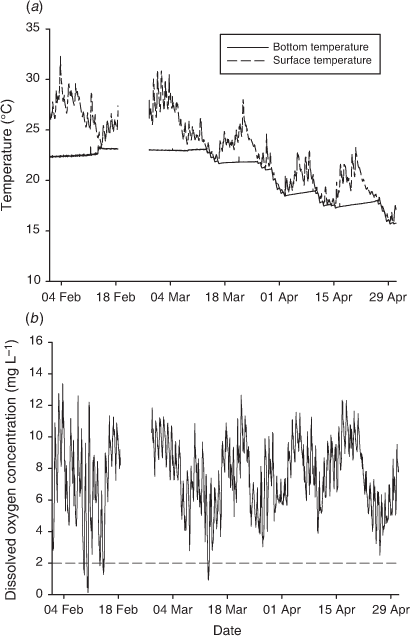
|
There were several hypoxic events (DO concentrations <2 mg L–1) during this period (Fig. 3b): the night of 8–9 February for 5 h; the night of 9–10 February for 8.5 h; the morning of 13 February for 2 h; the night of 13–14 February for 8 h; and the night of 13–14 March for 8 h.
In early 2019, the Venturi aerator suppressed thermal stratification at the outlet. Although there were multiple periods of thermal stratification at the reference station (Fig. 4) until the aerator ceased operation (Fig. 4a, dotted vertical line), there was only one brief period of stratification at the outlet of the Venturi aerator in mid-February, which coincided with a period when the aerator was turned off for maintenance (Fig. 4a). Furthermore, the thermal stratification was much weaker during this period of stratification compared with that at the reference station (see Fig. 3a). Unlike the reference station, before March 28 when the Venturi aerator was turned off, there were no instances where hypoxia was observed at the surface near the Venturi aerator outlet (Fig. 4b). Soon after operation of the Venturi aerator ceased, hypoxia rapidly formed in the bottom waters at this site (Fig. S2).
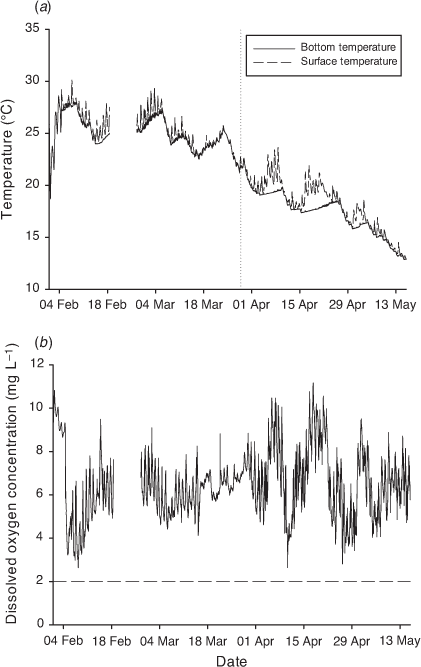
|
In summer 2019–20 a high-volume, single-port Venturi system was deployed in Weir 32 weir pool (2020-E). This time the system was driven by a 66-cm diesel-powered pump. A reference station (2020-F) was located ~1500 m upstream of the Venturi aerator outlet. Continuous temperature measurements showed that the reference station (2020-F) was thermally stratified (defined as a temperature difference between the surface and bottom of 0.1°C; Bormans and Webster 1997) for periods longer than 5 days on at least 9 occasions (Fig. 5). The weekly DO concentration profile at the reference station broadly followed the thermal stratification pattern (i.e. there were periods of hypoxia in the hypolimnion during periods of thermal stratifications and near-uniform oxygen concentrations throughout the water column following mixing; Fig. S3). However, at no stage did a destratification event lead to hypoxia throughout the water column at the reference station.
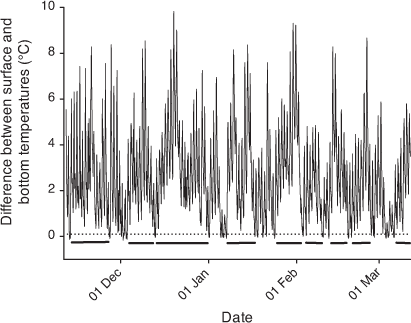
|
The high-volume Venturi aerator at Station 2020-E could maintain oxic conditions throughout the water column for a distance of up to ~500 m downstream of the Venturi aerator outlet. For example, on 31 January 2019 the water column at the reference station was thermally stratified (Fig. 5) and the DO concentration was hypoxic below a depth of ~2 m (Fig. 6). However, the oxygen concentration at Station 2020-E was oxic throughout the water column at both 25 and 175 m downstream of the aerator (a depth of 3.5 m; Fig. 6). By 500 m downstream of the aerator, the DO concentration at the deepest point measured (2 m) was similar to that at the reference station.
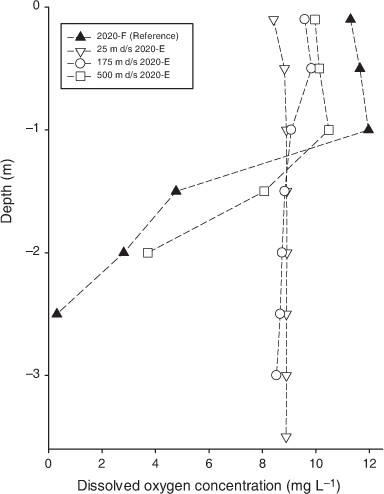
|
Multi-port Venturi aerators
In early 2019, multi-port aerators were deployed in two adjacent pools immediately downstream of Weir 32 on the Darling River (2019-A and 2019-B). The next isolated pool downstream (2019-C) was used as a reference pool. Following a period of thermal stratification lasting for a period of ~7 days (see Fig. S4), a cool change resulted in destratification of the reference pool on 5 March 2019, which, in turn, led to hypoxia throughout the water column (Fig. 7), causing the death of several fish (G. McCrabb, pers. comm.)
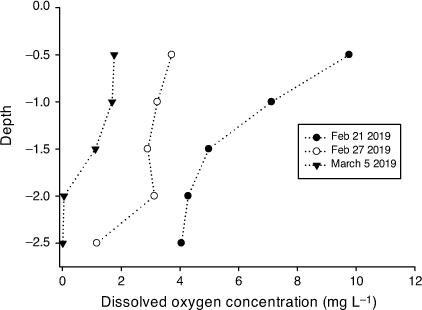
|
Transects taken on the same day in the two pools with multi-port aerators showed that although oxygen levels were low in both pools, they were above levels known to be lethal for native fish. For example, DO concentrations in 2019-A varied from ~3.7 mg L–1 adjacent to the aerator to 2.8–3.2 mg L–1 60 m away from the aerator (Fig. 8). In 2019-B, the multi-port aerator could maintain an oxic zone adjacent to the aerator but the effect dissipated with distance, with DO concentrations 100 m away from the aerator at a depth of 1 m similar to those seen in the reference pool (Fig. 9).
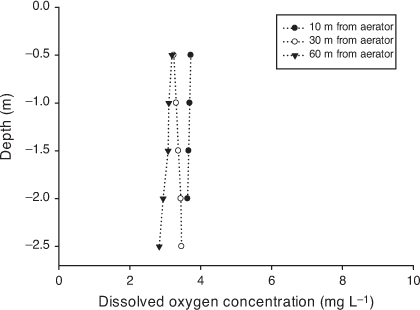
|
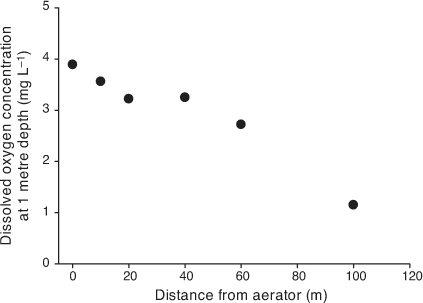
|
Multi-port aerators were also deployed in weir pools in the Darling River during the summer of 2019–20. Although there were several periods of stratification leading to hypoxia in the hypolimnion in both Weir 32 weir pool (adjacent to the township of Menindee) and Lake Wetherell (the weir pool immediately upstream of Weir 32 weir pool), subsequent weather-driven destratification did not lead hypoxia throughout the water column. However, the aerators clearly influenced the oxygen profile in their immediate vicinity compared with reference stations. For example, although hypoxia was present in the hypolimnion at the reference station upstream of the aerator deployed in Lake Wetherell (2020-B) on 16 January 2020, the oxygen concentration up to 100 m downstream of the aerator remained oxic (Fig. 10).
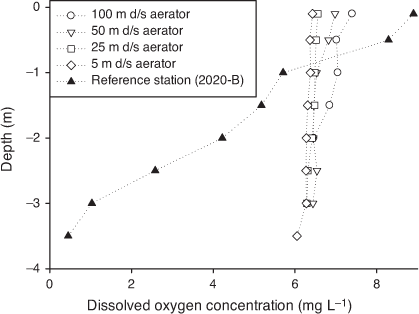
|
Solar-powered bubble-plume diffusers
The solar-powered bubble plume diffuser in the pool created by the block bank at Karoola (2019-E) was substantially less effective in modifying oxygen profiles than the high-volume, single-port Venturi aerator (2019-D). For example, Fig. 11 shows the oxygen concentration depth profiles at 2019-D, 2019-E and the reference station (2012-F) on 21 March 2019 during a period of thermal stratification in the block bank pool. Although there is a substantial difference between the DO concentration profile at 2019-D and 2019-F, the oxygen profiles (at the surface) for the reference station and 2019-E are very similar. This suggests that it is unlikely that the bubble-plume diffuser behind the block bank at Karoola station had a substantial impact on DO concentration in the pool. A side-scanning sonar image of the bubble plumes at 2019-D and 2019-E (Fig. S5) clearly shows that the bubble-plume profile of the high-volume, single-port Venturi aerator is ~1 order of magnitude wider at the water surface than that of the solar-powered bubble-plume diffuser.
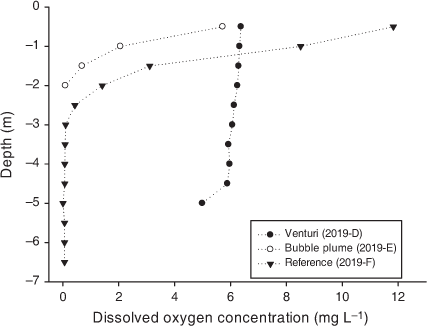
|
A solar-powered bubble-plume diffuser was also deployed in Pooncarie weir pool (2019-G). The DO concentration in the weir pool never fell to levels that would cause concern to large-bodied native fish (Fig. 12). Nevertheless, there was no substantial difference in the DO concentration at the bubble plume (2019-G; Fig. 11a) compared with the reference station (2019-H; Fig. 11b).
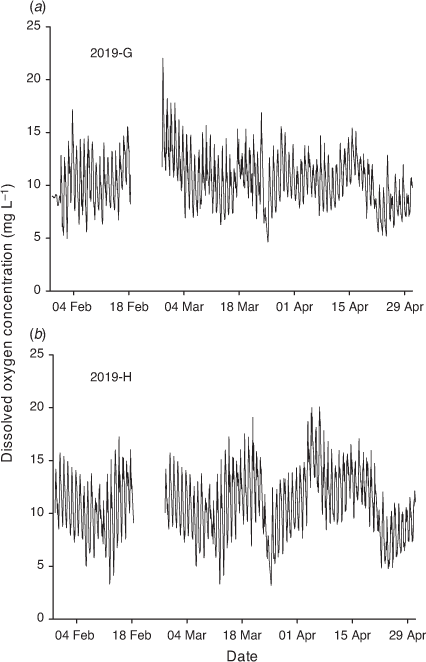
|
Multiple solar-powered bubble-plume diffusers were deployed in small, isolated pools in the Macquarie River downstream of Warren during the summer of 2019–20. Baseline measurements taken on 29 October 2019 show that all pools were stratified at a depth of 1–2 m before deployment of the bubble-plume diffuser (Fig. 13a). The depth of all treatment pools decreased by ~1 m over the course of the study. In general, although reference pools maintained a distinct oxycline, with hypoxia in the hypolimnion on most occasions, aerator pools generally remained mixed from November 2019 to January 2020. For example, Fig. 13b shows DO concentrations in reference pools and in pools with aerators on 18 and 19 December 2019. Although the reference pools all had a clear oxycline, the pools with aerators had an even DO concentration throughout the water column. Some stratification was visible in aerator pools on some sampling dates when aerators had temporarily stopped working because of falling pool levels. The non-aerated pools remained stratified for most of the study period, but some individual pools were periodically mixed during storm events with stronger winds (data not shown).
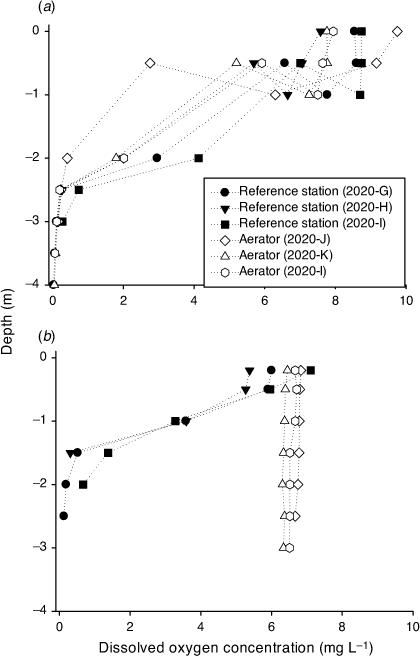
|
Trial of the ultra-fine bubble-injection pump
When the trial started, mean DO did not differ between the aerated and control ponds (Fig. 14a). Multiple changes were made to improve the performance of the pump between 21 March and 5 April, including increasing the size of the pump and condenser and changing the fittings. As a result, the mean DO concentration in the treated pond became consistently higher than that in the control pond (Fig. 14a). The aerated pond became supersaturated throughout its length and depth and, on 11 April, averaged 140% saturation (range 130–160%). The water remained supersaturated with DO at a concentration above that of the control pond until the pump was turned off. When water quality was measured 8 days after the pump was turned off, DO concentration had fallen back down to levels equivalent to that in the control pond (~90%). Importantly, at no stage did TGP in the aerated pond exceed the range of 110–120%, which is considered to be the lower limit for causing gas-bubble trauma in fish (Weitkamp and Katz 1980; Fig. 14b).
Discussion
It is likely that the operation of aerators in the Darling River prevented fish deaths in the Darling River in early 2019. The multi-port Venturi aerators in Pools 2019-A and 2019-B kept the DO concentration in both pools above ~3 mg L–1 on 5 March 2019, whereas the next adjacent pool became hypoxic, resulting in fish deaths. Similarly, the oxygen concentration near the single-port Venturi aerator at 2019-D remained oxic even though there were multiple periods of hypoxia during February and March 2019 at the reference station (2019-F) located in the same pool.
There was a clear relationship between the efficacy of the aerators and their energy consumption. Over summer 2019–20 in the lower Darling River, the two most effective aerators were the high-volume, single-port Venturi systems, with the system equipped with a 66-cm pump being able to maintain oxygen levels in a river reach that was ~500 m in length. However, these systems were also the most expensive to run, consuming hundreds of litres of diesel fuel per week. The multi-port Venturi aerators consumed less fuel (although still in the range of several hundred litres of diesel per week), but were also less effective, with a zone of influence of ~100 m from the aerator.
Although the solar-powered bubble-plume diffusers were essentially cost-free to run, the trials in the Darling and Macquarie rivers showed that their effectiveness depends on achieving sufficient power output relative to the surface area and depth of the pools. The purpose of the bubble-plume diffusers is to prevent stratification and hypoxia in the hypolimnion by maintaining a vertical flow pattern that allows bottom waters to be oxygenated by exposure to air at the surface. Therefore, single bubble-plume diffuser units operating only during daylight hours provided insufficient power to mix the weir pools in the Darling River trial. By contrast, the Macquarie River trial deployed two diffuser units per pool that were operated over a 24-h cycle by connecting the units to battery storage. This arrangement provided sufficient energy to successfully mix the Macquarie River pools. A further consideration in deploying the bubble-plume diffusers is the surface area of the pool relative to its depth. The diffusers are less effective in shallow waters with a larger surface area because they produce relatively large bubbles that rise rapidly to the surface, generating less vertical flow than in a deeper pool of the same surface area. The weir pools in the Darling River trial had a larger surface area than the refuge pools in the Macquarie River trial, and this may also explain why the solar-powered diffusers were less effective than the diesel- or diesel–electric-powered system in the Darling River weir pools.
The trial of the ultra-fine bubble pump was also promising. The pump supersaturated DO in the treated pond, making DO concentration significantly higher than the control, without raising TGP. The advantage of smaller bubbles over bubbles with a diameter of ~1 mm is that they have a much larger surface-area to volume ratio (more than 95% of the of gas molecules in the suspension can exist in the dissolved phase; Kim et al. 2020) and they are more stable, remaining in the water column for far longer (Thomas et al. 2021). Because of this, they are more efficient at increasing the DO concentration of hypoxic water and do so in a more energy-efficient way (Ovezea 2009). An important observation in the present trial was that the ultra-fine bubble pump did not lead to an elevation in TGP. The reason why this technology was trialled in a hatchery pond rather than in the river was due to the fear that saturation of the water with ultra-fine oxygen bubbles could lead to elevated total dissolved gas pressures that can be lethal to fish. When the total dissolved gas pressure exceeds 110%, fish restricted to shallow water can develop gas-bubble trauma, where emboli form in the organs and gills (Pleizier et al. 2020). This can disrupt oxygen absorption and eventually kill fish. Although there may have been some natural differences in the TGP between ponds due to algal activity, TGP followed a similar trajectory through time in both ponds and, when variance around the mean values was observed (i.e. minimum and maximum values), TGP was only significantly higher in the control pond on two occasions. Critically, during the trial, the TGP did not approach levels considered of concern for gas-bubble disease in either pond.
Future deployment of aerators in inland waterways
The installation of aerators in the Darling River in early 2019 occurred under extremely short time constraints and in the face of an ongoing environmental emergency. Therefore, aerators were selected primarily based on availability. One of the issues faced was the ability to supply energy to the aerators in remote locations, hence the reliance on solar energy or diesel fuel for power. There is the potential to drive down the cost of operating the aerators without compromising efficacy. First, hybrid solar–fossil fuel electrical generators are commercially available and could be used to power aerators, and would be even more adaptable if they included battery technology. Furthermore, if sufficiently powerful, the aerators do not need to run continuously. Linked DO and temperature sensors in conjunction with computer models to predict the onset of hypoxia could be used to improve the timing of aerator operation, noting that turning on an aerator in a stratified pool can lead to mixing and potential hypoxia. Nevertheless, supplying sufficient power to operate effective aerators in remote locations will be expensive.
There are also other factors to consider when selecting aerators. The aerator system needs to be able to be operated at night or early in the morning when DO concentrations in the water column are lowest and mixing events are more likely to occur. If solar-powered systems are deployed, this would require either battery backup or an alternative fuel source to allow the aerator to operate at night. The system needs to operate under extreme conditions, including air temperatures exceeding 50°C, water temperatures exceeding 35°C, high ultraviolet radiation and high turbidity in the water column.
The system should be low maintenance and, ideally, the ongoing performance of the aerator could be assessed remotely. The aerators need to be light and small enough to be deployed in areas with steep banks. The systems should be portable to allow for storage and redeployment in different areas as required. Finally, to the extent possible, the system should be vandal proof.
The deployment of aerators should only be considered a very localised, short-term solution. To supply aerators can costs thousands of dollars to many tens of thousands of dollars per pool, with operating costs of up to several thousand dollars per week depending on the fuel source and the size of the pump. Furthermore, even the most effective aerators only affect DO concentrations over very small spatial scales (hundreds to, at best, thousands of square metres) compared with the surface area of the lowland rivers in the Murray–Darling Basin (millions of square metres). Although aerators play a role in emergency responses, longer-term solutions need to be assessed. In particular, the use of environmental flows to mitigate the risk of hypoxia should be strongly considered. Such flows could be used to prevent thermal stratification in the first place. Alternatively, flow pulses could be used to periodically disrupt thermal stratification before DO concentrations in the hypolimnion reach levels low enough that they would lead to hypoxia on turn over. Effective management of hypoxia in inland waterways in Australia will increasingly become important into the future as periods of hypoxia become more prevalent in the face of a changing climate (Baldwin 2020a).
Conflicts of interest
Craig Boys is a Guest Editor for the ‘Fish Kills’ special issue of Marine and Freshwater Research. Despite this relationship, he took no part in the review and acceptance of this manuscript, in line with the publishing policy. The authors declare that they have no further conflicts of interest.
Declaration of funding
The operation of the aerators in the Darling River over the summer of 2019–20 and the water quality sampling and data analysis were funded by the Murray–Darling Basin Authority (MDBA) and NSW Department of Primary Industries (DPI) Fisheries. The nano-bubble trial was supported by DPI Fisheries. Parts of this paper are based on reports prepared for, and funded by, the MDBA (Baldwin 2019b, 2020b; licenced under a Creative Commons Attribution 4.0 Australian Licence).
Acknowledgements
The authors acknowledge the individuals and organisations who mobilised to install aerators in the lower Darling River and Macquarie River following the fish deaths in 2018–19. Their efforts undoubtedly prevented subsequent fish deaths. Water quality sampling and data analysis in the Darling River in early 2019 were funded by the MDBA; sampling was undertaken by Sunraysia Environmental under contract to the MDBA. Water quality sampling in 2019–20 was performed by Graeme McCrabb (contracted to Millewa Pumping) and Mr Jimmy Walker (DPI Fisheries). The authors also specifically thank Mr Graeme McCrabb and Paul Grosse for their insights into the lower Darling River and Mr Chris Clarke and Mr Scott Clarke (Millewa Pumping), Mr Ivan Robertson (Water Movers Australia) and Mr Adrian Parsons (APPumps) for useful discussions on the aerators they supplied. The authors thank the staff of the Narrandera Fisheries Centre, particularly Patrick Martin, Tom Butterfield and Ian Wooden for setting up and collecting data for the trial, and Hakan Ozcelik and Howard Sachs from Custom Fluids for supplying the ultra-fine bubble pump. The authors thank the staff who installed and monitored the Macquarie River aerators through the summer heat: Rod Wilson, Matt Donnelly, Carolina Pheysey, Josh Flint, Bernie Finch, Hannah Took, Chris Ulvr-Green, Rebecca Sullivan (WaterNSW), Duncan McGregor and Josh Loxley (EPA). The authors acknowledge Katherine Cheshire and other DPI staff who provided earlier comments on the manuscript.
References
Baldwin, D. S. (2019a). Weir stratification and hypoxic water management – Murrumbidgee River 2019. A report to the Commonwealth Environmental Water Office. (publisher.) Available at https://www.environment.gov.au/water/cewo/publications/weir-stratification-hypoxic-water-management-murrumbidgee-river-2019Baldwin, D. S. (2019b). Stratification, mixing and fish deaths in the lower Darling River. A report prepared for the Murray–Darling Basin Authority. (MDBA.) Available at https://www.mdba.gov.au/sites/default/files/pubs/Independent-report-stratification-mixing-and-fish-deaths-in-the-Lower-Darling-River.pdf
Baldwin, D. S. (2020a). Water quality in the Murray–Darling Basin: The potential impacts of climate change. In ‘Ecohydrology from catchment to coast Murray–Darling Basin, Australia: Its Future Management’. (Eds B. T. Hart, N. R. Bond, N. Byron, C. A. Pollino, and M. J. Stewardson.) pp 137–159. (Elsevier: Amsterdam, Netherlands.)
Baldwin, D. S. (2020b). Assessing the response to the risk of hypoxia in the lower Darling River: November 2019 until March 2020. A report prepared for the Murray–Darling Basin Authority. (MDBA.) Available at https://www.mdba.gov.au/sites/default/files/pubs/Assessing%20the%20response%20to%20the%20risk%20of%20hypoxia%20in%20the%20lower%20Darling%20River%20November%202019%20-%20March%202020.pdf
Bormans, M., and Webster, I. T. (1997). A mixing criterion for turbid waters. Environmental Modelling & Software 12, 329–333.
| A mixing criterion for turbid waters.Crossref | GoogleScholarGoogle Scholar |
Boys, C. A., Baldwin, D. S., Ellis, I., Pera, J., and Cheshire, K. (2021). Review of options for creating and maintaining oxygen refuges for fish during destratification-driven hypoxia in rivers. Marine and Freshwater Research , .
| Review of options for creating and maintaining oxygen refuges for fish during destratification-driven hypoxia in rivers.Crossref | GoogleScholarGoogle Scholar |
Dunalska, J. A., Sienska, J., and Szymanski, D. (2015). The use of biopreparations in lake restoration – experimental research. Oceanological and Hydrobiological Studies 44, 500–507.
| The use of biopreparations in lake restoration – experimental research.Crossref | GoogleScholarGoogle Scholar |
Ellis, I., and Meredith, S. (2004). Guidelines for future release effects on lower Darling River fish deaths, Consultancy report for NSW Department of Infrastructure, Planning and Natural Resources, Murray–Darling Freshwater Research Centre, Mildura, Vic., Australia.
Environment Protection and Heritage Council and the Natural Resources Management Ministerial Council (2011). National Guidance on the Management of Acid Sulfate Soils in Inland Aquatic Ecosystems. (Department of Environment Water Heritage and the Arts.) Available at http://www.environment.gov.au/water/publications/quality/guidance-for-management-of-acid-sulfate-soils.html
Gehrke, P. C. (1988). Response-surface analysis of teleost cardiorespiratory responses to temperature and dissolved oxygen. Comparative Biochemistry and Physiology. A. Comparative Physiology 89, 587–592.
| Response-surface analysis of teleost cardiorespiratory responses to temperature and dissolved oxygen.Crossref | GoogleScholarGoogle Scholar |
Gomez, R., Isabel, M., Baldwin, D. S., and Dahm, C. (2017). Water physiochemistry in intermittent rivers and ephemeral streams. In ‘Intermittent Rivers: Ecology and Management’. (Eds T. Datry, N. Bonada, and A. Boulton.) pp. 109–129. (Academic Press: Burlington, VT, USA)
International Organization for Standardization (2017). ISO 20480-1:2017. Fine Bubble technology – general principles for usage and measurement of fine bubbles – part 1: terminology. (ISO, Geneva, Switzerland.) Available at https://www.iso.org/standard/68187.html
Kim, E., Choe, J. K., Kim, B. H., Kim, J., Park, J., and Choi, Y. (2020). Unraveling the mystery of ultrafine bubbles: establishment of thermodynamic equilibrium for sub-micron bubbles and its implications. Journal of Colloid and Interface Science 570, 173–181.
| Unraveling the mystery of ultrafine bubbles: establishment of thermodynamic equilibrium for sub-micron bubbles and its implications.Crossref | GoogleScholarGoogle Scholar | 32146244PubMed |
King, A. J., Tonkin, Z., and Lieshcke, J. (2012). Short-term effects of a prolonged blackwater event on aquatic fauna in the Murray River, Australia: considerations for future events. Marine and Freshwater Research 63, 576–586.
| Short-term effects of a prolonged blackwater event on aquatic fauna in the Murray River, Australia: considerations for future events.Crossref | GoogleScholarGoogle Scholar |
McDonnell, A. J., and Kountz, R. R. (1966). Algal respiration in a eutrophic environment. Journal – Water Pollution Control Federation 38, 841–847.
Ovezea, A. (2009). Saving energy: using fine bubble diffusers. Filtration & Separation 46, 24–27.
| Saving energy: using fine bubble diffusers.Crossref | GoogleScholarGoogle Scholar |
Pleizier, N. K., Algera, D., Cooke, S. J., and Brauner, C. J. (2020). A meta‐analysis of gas bubble trauma in fish. Fish and Fisheries 21, 1175–1194.
| A meta‐analysis of gas bubble trauma in fish.Crossref | GoogleScholarGoogle Scholar |
Small, K., Kopf, R. K., Watts, R. J., and Howitt, J. (2014). Hypoxia, blackwater and fish kills: experimental lethal oxygen thresholds in juvenile predatory lowland river fishes. PLoS One 9, e94524.
| Hypoxia, blackwater and fish kills: experimental lethal oxygen thresholds in juvenile predatory lowland river fishes.Crossref | GoogleScholarGoogle Scholar | 24728094PubMed |
Sullivan, L., Bush, R., and Fyfe, D. (2002). Acid sulfate soil drain ooze: distribution, behaviour and implications for acidification and deoxygenation of waterways. In ‘Acid Sulfate Soils in Australia and China’. (Eds C. Lin, M. Melville, and L. Sullivan.) pp. 91–99. (Science Press: Beijing, PR China.)
Thomas, B., Ohde, D., Matthes, S., Engelmann, C., Bubenheim, P., Terasaka, K., Schlüter, M., and Liese, A. (2021). Comparative investigation of fine bubble and macrobubble aeration on gas utility and biotransformation productivity. Biotechnology and Bioengineering 118, 130–141.
| Comparative investigation of fine bubble and macrobubble aeration on gas utility and biotransformation productivity.Crossref | GoogleScholarGoogle Scholar | 32886350PubMed |
Vertessy, R., Barma, D., Baumgartner, L., Bond, N., Mitrovic, S., and Sheldon, F. (2019). Independent Assessment of the 2018–19 fish deaths in the lower Darling. (Murray–Darling Basin Authority and Australian Government, Australia.)
Watts, R. J., Kopf, R. K., McCasker, N., Howitt, J. A., Conallin, J., Wooden, I., and Baumgartner, L. (2018). Adaptive Management of Environmental Flows: Using Irrigation Infrastructure to Deliver Environmental Benefits During a Large Hypoxic Blackwater Event in the Southern Murray–Darling Basin, Australia. Environmental Management 61, 469–480.
| Adaptive Management of Environmental Flows: Using Irrigation Infrastructure to Deliver Environmental Benefits During a Large Hypoxic Blackwater Event in the Southern Murray–Darling Basin, Australia.Crossref | GoogleScholarGoogle Scholar | 28929206PubMed |
Weitkamp, D. E., and Katz, M. (1980). A review of dissolved gas supersaturation literature. Transactions of the American Fisheries Society 109, 659–702.
| A review of dissolved gas supersaturation literature.Crossref | GoogleScholarGoogle Scholar |
Whitworth, K., Baldwin, D. S., and Kerr, J. (2012). Drought, floods and water quality: drivers of a severe hypoxic blackwater event in a major river system (the southern Murray–Darling Basin, Australia). Journal of Hydrology 450–451, 190–198.
| Drought, floods and water quality: drivers of a severe hypoxic blackwater event in a major river system (the southern Murray–Darling Basin, Australia).Crossref | GoogleScholarGoogle Scholar |
Whitworth, K. L., Kerr, J., Mosley, L. M., Conallin, J., Hardwick, L., and Baldwin, D. S. (2013). Options for managing hypoxic blackwater in river systems: case studies and frameworks. Environmental Management 52, 837–850.
| Options for managing hypoxic blackwater in river systems: case studies and frameworks.Crossref | GoogleScholarGoogle Scholar | 23912322PubMed |



